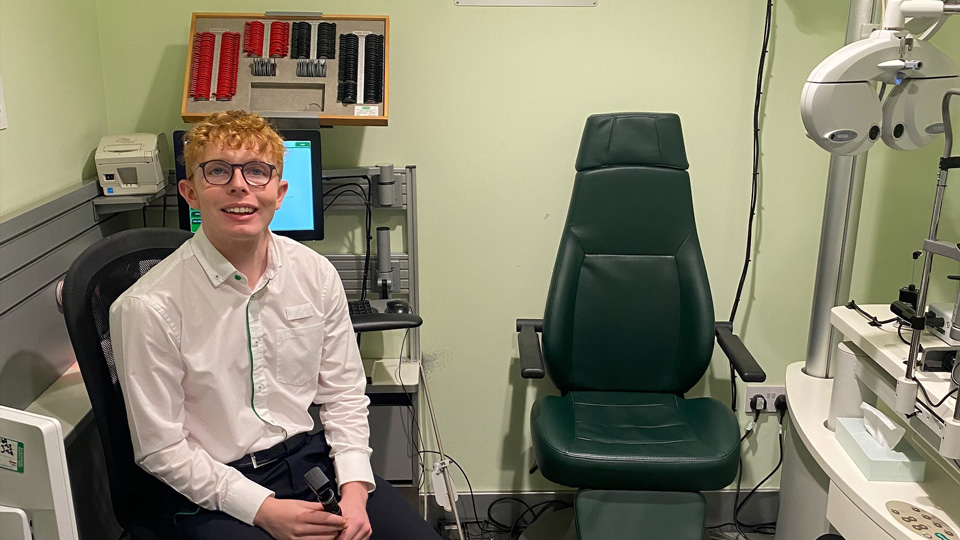- OT
- Life in practice
- Career development
- Diagnosis and difficult conversations as a pre-reg
Pre-reg focus
Diagnosis and difficult conversations as a pre-reg
Hayley Smith, pre-reg optometrist at Peter Ivins Eye Care, tells OT why she is finding technology a vital tool as she approaches Stage two
3 min read

My pre-reg journey has been exciting and busy, with each day bringing a new range of fascinating patients.
At first, when I worked part-time in the practice during university, the complex equipment seemed quite daunting. However, I was able to build up my knowledge and confidence using each machine. I could get used to the equipment when I was pre-screening patients, and then discuss with the optometrist how to interpret the results.
It has been very interesting learning how to use each machine and how to integrate them into the investigation and management of patients
An interest in complex contact lenses
Now, during pre-reg, the technology has allowed me to upskill and start fitting complex contact lenses using the topographer. I have worked with my colleagues to learn how to fit scleral lenses, which was a really rewarding process as it improved the vision in keratoconus patients to levels they had not reached before. This has really sparked my interest in complex lenses, and I am excited to fit more of these in the future.As well as these, I have also had some experience with ortho-k lenses to correct myopia. It has been really interesting to see how effective these lenses are in slowing down the rate of myopia progression using the Myopia Master, which measures axial length. It is a fulfilling part of the job: the child is happy to be able to continue with their sports and daily activities as normal, and the parents are always extremely thankful and relieved that the lenses are working.
Diagnosing cystoid macular oedema
Using the equipment has also made me feel more confident in my diagnoses and management plans. For example, I examined a patient with a branch retinal vein occlusion and, with the use of optical coherence tomography (OCT), discovered cystoid macular oedema (CMO) as a result. This was an important find, as the management of a case without CMO is slightly different to one with CMO. The OCT and fundus camera also enable a longer and more in-depth discussion with my supervisor and are useful to refer back to if needed.Despite my confidence improving, I still find it difficult to break bad news to patients, for example with a branch retinal vein occlusion case. It is difficult to strike the balance between being empathetic, whilst emphasising the urgency of the situation. Whilst I do feel that I have improved since the start of pre-reg, it is still something I am working on.
I am now preparing for my Stage two visit, which is very different from Stage one. I had found my flow and what worked best for me when revising for Stage one visits, however Stage two is a different format, so I am having to work out which approach is best when revising the overarching competencies. Many of the case scenarios are a good talking point with my colleagues and it will be interesting to hear how more experienced optometrists would approach them. I still can’t comprehend that I am already working towards Stage two – this year is flying by.
The one change I’d like to see in eye care with a potential change in government is...
I am very lucky to be working in Scotland, where sight tests are free to all, no matter the age or condition. We also have a supplementary eye exam, meaning every optometrist provides emergency eye services. This allows every optometrist in Scotland the opportunity to see emergency eye conditions, no matter how big or small, and gives them more responsibility in patient care. Implementing free sight tests for everyone and supplementary tests across the whole of the UK would not only be more convenient for patients, but would potentially increase the uptake in sight tests and minimise the risk of slowly progressing eye conditions being missed.
Oran says...

At this stage of my pre-reg I am working towards…
Preparing for my visit three, which will take place in May. I am focussing on improving my clinical skills for the direct observation section of the visit by practising various tests, which I may use as part of this.
I have found adapting to the clinical technology used in my practice…
Difficult to get used to at the start, but that it has really helped my clinical practice. Fundus photos and OCT have given me confidence in my ocular examination and are useful for detecting the presence and progression of ocular disease. My colleagues at Specsavers are supportive as I progress and develop my clinical skills.
The next thing I am looking forward to is...
Getting hospital eye service experience. My Specsavers’ supervisor has arranged for me to sit in on a low vision clinic in the next few weeks and is looking to arrange for me to sit in on an orthoptics clinic. This will give me great insights when it comes to managing these patients in future.
The one thing I’d like to see change in eye care with a potential new government...
More support primary care optometry, because as a profession we have the skills, expertise and technology to build on what we already do for the benefit of patients and the NHS. Working in partnership with our colleagues in secondary care would help to take pressure off GPs and hospitals.
Oran O’Connor is a pre-reg optometrist at Specsavers Newtownards
Preparing for my visit three, which will take place in May. I am focussing on improving my clinical skills for the direct observation section of the visit by practising various tests, which I may use as part of this.
I have found adapting to the clinical technology used in my practice…
Difficult to get used to at the start, but that it has really helped my clinical practice. Fundus photos and OCT have given me confidence in my ocular examination and are useful for detecting the presence and progression of ocular disease. My colleagues at Specsavers are supportive as I progress and develop my clinical skills.
The next thing I am looking forward to is...
Getting hospital eye service experience. My Specsavers’ supervisor has arranged for me to sit in on a low vision clinic in the next few weeks and is looking to arrange for me to sit in on an orthoptics clinic. This will give me great insights when it comes to managing these patients in future.
The one thing I’d like to see change in eye care with a potential new government...
More support primary care optometry, because as a profession we have the skills, expertise and technology to build on what we already do for the benefit of patients and the NHS. Working in partnership with our colleagues in secondary care would help to take pressure off GPs and hospitals.
Oran O’Connor is a pre-reg optometrist at Specsavers Newtownards



Comments (0)
You must be logged in to join the discussion. Log in